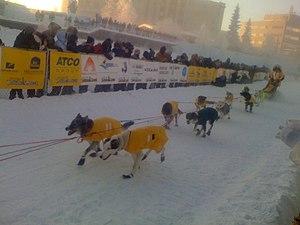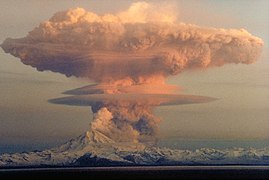Portal:Alaska
 Introduction   Alaska (/əˈlæskə/ ə-LASS-kə) is a non-contiguous U.S. state on the northwest extremity of North America. Part of the Western United States region, it is one of the two non-contiguous U.S. states, alongside Hawaii. Alaska is also considered to be the northernmost, westernmost, and easternmost (the Aleutian Islands cross the 180th meridian into the eastern hemisphere) state in the United States. It borders the Canadian territory of Yukon and the province of British Columbia to the east. It shares a western maritime border, in the Bering Strait, with Russia's Chukotka Autonomous Okrug. The Chukchi and Beaufort Seas of the Arctic Ocean lie to the north, and the Pacific Ocean lies to the south. Technically, it is a semi-exclave of the U.S., and is the largest exclave in the world. Alaska is the largest U.S. state by area, comprising more total area than the following three largest states of Texas, California, and Montana combined, and is the sixth-largest subnational division in the world. It is the third-least populous and most sparsely populated U.S. state, but is, with a population of 736,081 as of 2020, the continent's most populous territory located mostly north of the 60th parallel, with more than quadruple the combined populations of Northern Canada and Greenland. The state contains the four largest cities in the United States by area, including the state capital of Juneau. The state's most populous city is Anchorage, and approximately half of Alaska's residents live within its metropolitan area. Indigenous people have lived in Alaska for thousands of years, and it is widely believed that the region served as the entry point for the initial settlement of North America by way of the Bering land bridge. The Russian Empire was the first to actively colonize the area beginning in the 18th century, eventually establishing Russian America, which spanned most of the current state and promoted and maintained a native Alaskan Creole population. The expense and logistical difficulty of maintaining this distant possession prompted its sale to the U.S. in 1867 for US$7.2 million (equivalent to $157 million in 2023). The area went through several administrative changes before becoming organized as a territory on May 11, 1912. It was admitted as the 49th state of the U.S. on January 3, 1959. Abundant natural resources have enabled Alaska— with one of the smallest state economies—to have one of the highest per capita incomes, with commercial fishing, and the extraction of natural gas and oil, dominating Alaska's economy. U.S. Armed Forces bases and tourism also contribute to the economy; more than half of the state is federally-owned land containing national forests, national parks, and wildlife refuges. It is among the most irreligious states, one of the first to legalize recreational marijuana, and is known for its libertarian-leaning political culture, generally supporting the Republican Party in national elections. The Indigenous population of Alaska is proportionally the second highest of any U.S. state, at over 15 percent, after only Hawaii. (Full article...) Entries here consist of Good and Featured articles, which meet a core set of high editorial standards.
 Three hundred and eighty-six people have participated in the Yukon Quest, an annual international 1,000-mile sled dog race between Fairbanks, Alaska and Whitehorse, Yukon. It has been called the "most difficult sled dog race in the world" and the "toughest race in the world". The race's route follows the Yukon River for much of its course and travels over four mountains: King Solomon's Dome, Eagle Summit, American Summit, and Rosebud Summit. Its length is equivalent to the distance between England and Africa, and the distance between some checkpoints is equivalent to the breadth of Ireland. Yukon Quest attracts anywhere from 18 (in 2014) to 47 (in 1988 and 1989) mushers each year. Because of the competition's difficulty, about one-third of the entrants do not finish. Of the 776 entries from the race's inception in 1984 to 2007, 263 did not finish—a scratch rate of 33.9 percent. The racers have come from various professions: taxicab drivers, a swimming instructor, a coal miner, a tax assessor, a lawyer, fur trappers, journalists, and a car salesman, among others. At the conclusion of the competition, several racers are recognized by special awards given for various feats performed on the trail. The most notable of these accomplishments is the championship award, given to the winner of the race. Accompanying this is the Golden Harness Award, given to the winner's two lead sled dogs. The next significant award is the Veterinarians Choice Award, which is given to the musher who maintains the best care of his or her dogs during the race, as voted by race veterinarians. Other awards include the Challenge of the North Award—given to the musher who "exemplifies the spirit of the Yukon Quest"—and the sportsmanship award, given to the most sportsmanlike competitor, as chosen by a vote of the mushers. Following the 2011 race, event organizers created the Silver Award to recognize musher Brent Sass for guiding two sled dog teams out of a blizzard atop American Summit. The Silver Award is not an annual award, and to date, Sass is its only recipient. (Full article...) TopicsCategoriesSelected article -St. Lawrence Island (Central Siberian Yupik: Sivuqaq, Russian: Остров Святого Лаврентия, romanized: Ostrov Svyatogo Lavrentiya) is located west of mainland Alaska in the Bering Sea, just south of the Bering Strait. The village of Gambell, located on the northwest cape of the island, is 50 nautical miles (95 kilometers) from the Chukchi Peninsula in the Russian Far East. The island is part of Alaska, but closer to Russia and Asia than to the Alaskan and North American mainland. St. Lawrence Island is thought to be one of the last exposed portions of the land bridge that once joined Asia with North America during the Pleistocene period. It is the sixth largest island in the United States and the 113th largest island in the world. It is considered part of the Bering Sea Volcanic Province. The Saint Lawrence Island shrew (Sorex jacksoni) is a species of shrew endemic to St. Lawrence Island. The island is jointly owned by the predominantly Siberian Yupik villages of Gambell and Savoonga, the two main settlements on the island. (Full article...) Selected picture -General imagesThe following are images from various Alaska-related articles on Wikipedia.
Recognized content
Featured articlesGood articles
Featured pictures
Former featured pictures
Related Portals
Related WikiProjectsState facts
State symbols:
Tasks
Associated WikimediaThe following Wikimedia Foundation sister projects provide more on this subject:
Discover Wikipedia using portals |































































